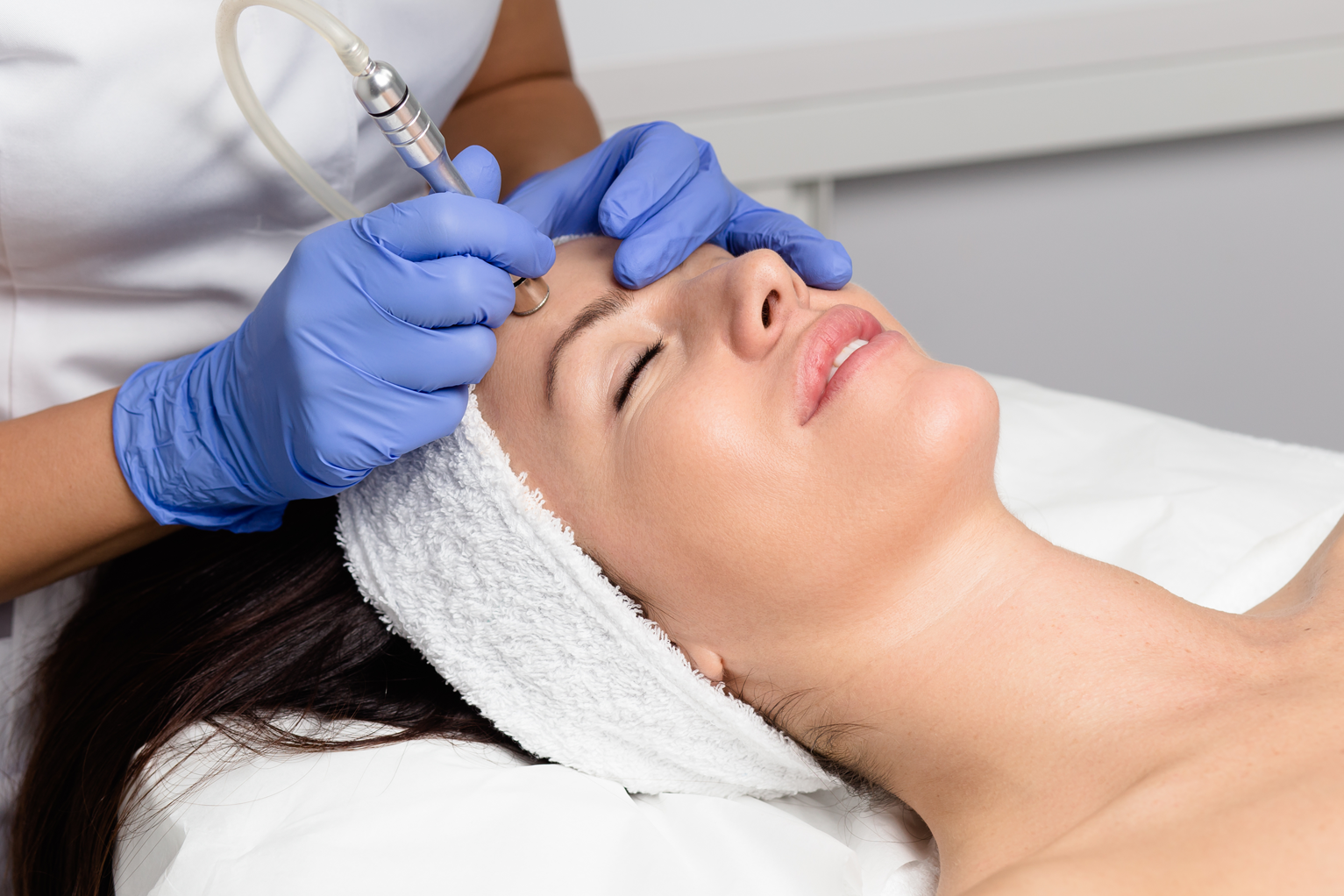Investing in your skin’s health and appearance through microdermabrasion can be a transformative experience. Say goodbye to dull, lifeless skin and hello to a radiant and rejuvenated complexion with microdermabrasion.
Microdermabrasion is a non-invasive cosmetic procedure that gently exfoliates the top layer of your skin, removing dead skin cells and stimulating the production of new ones.
Microdermabrasion can also enhance the absorption of skincare products and make your makeup look smoother and more flawless.
Microdermabrasion is a popular dermatological procedure that gives your skin a youthful appearance. It is a non-invasive treatment that gently removes the top layer of skin, revealing a smoother and more radiant complexion.
But what exactly happens during a microdermabrasion facial, and what are the benefits and risks of this treatment?
Types of Microdermabrasion
There are two main microdermabrasion procedures: crystal microdermabrasion and diamond microdermabrasion. Both types aim to exfoliate the skin effectively, but they differ in the method used.
In crystal microdermabrasion, microfine crystals are sprayed onto the skin and then vacuumed back up, similar to a high-powered scrub.
On the other hand, diamond microdermabrasion uses a diamond-tipped wand to exfoliate the skin without using crystals. Both types of microdermabrasion have their benefits and can help improve the skin’s texture, tone, and appearance.
How Does Microdermabrasion Work?
During a microdermabrasion treatment, the skin is first cleansed to remove dirt and oil. Then, the chosen method of exfoliation (crystals or diamond-tipped wand) is applied to the skin in gentle, circular motions. This process helps to remove dead skin cells and stimulate collagen production.
Depending on the treated area, a microdermabrasion facial usually takes 30 to 60 minutes. You’ll lie on a comfortable table, and your skin will be cleansed and prepped. Then, your aesthetician will use a handheld device that sprays or rubs fine crystals or a diamond tip onto your skin. The device also has a vacuum that sucks up the crystals and the loosened skin cells. You may feel a mild scratching or sanding sensation, but it should not be painful. The aesthetician will move the device over your face, paying special attention to any problem areas.
The exfoliation process also helps to improve blood circulation to the skin, resulting in a brighter and more youthful complexion. After the procedure, a moisturizer and sunscreen are typically applied to protect and hydrate the skin.
What are the benefits of microdermabrasion?
Microdermabrasion has many benefits for your skin.
- Smoother Skin: Microdermabrasion helps to remove the outer layer of dead skin cells, revealing a smoother and more even skin texture.
- Brighter Complexion: Microdermabrasion can give the skin a radiant and healthy glow by exfoliating the skin and removing dullness.
- Reduced Appearance of Fine Lines: The exfoliation process stimulates collagen production, which can help reduce the appearance of fine lines and wrinkles.
- Even Skin Tone: Microdermabrasion can help fade dark spots, hyperpigmentation, and acne scars, resulting in a more even skin tone.
- Cleaned-Out Pores: The exfoliation process can help unclog and minimize the appearance of pores, reducing the likelihood of breakouts.
Microdermabrasion can also make your skin more receptive to other treatments, such as chemical peels, laser therapy, or topical products. Microdermabrasion can be suitable for all skin types and colors, with minimal downtime and side effects.
What are the risks of microdermabrasion?
Microdermabrasion is generally considered a safe procedure, but there are some potential risks and complications that you should be aware of:
- Skin irritation, redness, swelling, or bruising
- Sensitivity to sun exposure or skincare products
- Infection or scarring
- Changes in skin color or pigmentation
- Eye injury from stray crystals
To minimize these risks, you should choose a qualified and experienced professional to perform the procedure. You should also follow the aftercare instructions from your aesthetician, such as avoiding sun exposure, using gentle cleansers and moisturizers, and refraining from picking or scratching your skin.
How Often Should You Have Treatments?
The number of microdermabrasion treatments needed varies depending on individual skin concerns and goals. In general, a series of treatments is recommended to achieve optimal results. Most individuals undergo six to ten treatments scheduled seven to fourteen days apart.
Your technician will assess your skin during your consultation and recommend the appropriate treatment plan. They will consider skin type, specific concerns, and desired outcomes.
It is important to note that microdermabrasion results are cumulative, meaning that the full benefits of the treatment may not be immediately apparent. With each subsequent session, you will notice an improvement in your skin’s texture, tone, and overall appearance.
Is Microdermabrasion Right For You?
Microdermabrasion can improve your skin’s appearance and health, but it is not for everyone.
You should consult with your dermatologist or aesthetician before undergoing this procedure. Some factors that may make you ineligible for microdermabrasion include:
- Active acne or rosacea
- Open wounds or infections
- Eczema or psoriasis
- Dermatitis or allergic reactions
- Skin cancer or precancerous lesions
- Diabetes or other medical conditions that affect wound healing
- Taking blood thinners or isotretinoin
If you have any of these conditions, you may want to explore other alternatives that are more suitable for your skin.
The Microdermabrasion Procedure
Before undergoing a microdermabrasion treatment, it’s important to consult a dermatologist or esthetician. During this consultation, your skincare professional will assess your skin and discuss your goals and expectations for the treatment.
On the day of your microdermabrasion session, you will be led to the treatment room and asked to change into a gown. Your technician will cleanse your face to prepare your skin for the procedure. Then, depending on the microdermabrasion type, either microfine crystals or a diamond-tipped wand will be used to exfoliate your skin.
The technician will gently move the exfoliation tool across your skin in circular motions, targeting specific areas of concern. The procedure itself is usually painless and takes about 30 minutes. Afterward, your technician will cleanse your face to remove any remaining exfoliation residue and apply moisturizer and sunscreen to protect and hydrate your skin.
Preparation
To ensure the best results and minimize the risk of side effects, properly preparing for your microdermabrasion session is important. Here are some tips to follow:
- Avoid Sun Exposure: It is recommended to avoid excessive sun exposure for a week before your treatment. Sunburned or tanned skin may be more sensitive during the procedure.
- Discontinue Use of Certain Products: Avoid using retinoids, glycolic acid, and exfoliating products for a few days before your session. These products can increase skin sensitivity.
- Remove Makeup: Come to your treatment with a clean face, free from makeup or skincare products. This will ensure that the exfoliation process is effective.
- Inform Your Technician: If you have any specific skin concerns or conditions, such as allergies or skin sensitivities, inform your technician before the procedure.
By following these preparation guidelines, you can ensure that your skin is in the best condition for the microdermabrasion treatment.
Aftercare and Recovery
After your microdermabrasion session, properly caring for your skin is important to optimize the results and promote healing. Here are some tips for post-treatment care:
- Avoid Sun Exposure: Your skin may be more sensitive to the sun after the procedure. Protecting your skin using a broad-spectrum sunscreen with SPF 30 or higher is crucial.
- Moisturize Regularly: Use a gentle moisturizer twice daily to hydrate your skin. This will help soothe any dryness or flakiness after the treatment.
- Avoid Harsh Products: Avoid harsh skincare products, such as exfoliants or retinoids, for a few days after the procedure. Stick to gentle cleansers and moisturizers to allow your skin to heal.
- Stay Hydrated: Drink plenty of water to keep your skin hydrated from within. Hydration is essential for maintaining healthy and glowing skin.
- Follow Your Technician’s Recommendations: Your technician may provide specific instructions for aftercare based on your skin type and the specific treatment performed. Be sure to follow their recommendations for the best results.
Potential Side Effects of Microdermabrasion
While microdermabrasion is generally considered safe, there are some potential side effects to be aware of. These side effects are usually mild and temporary, but discussing them with your technician before undergoing the procedure is important. Some possible side effects may include:
- Redness: Your skin may appear slightly red or flushed immediately after the treatment. This is a normal reaction and should subside within a few hours.
- Sensitivity: After the procedure, your skin may be more sensitive than usual. Avoid using harsh skincare products or exposing your skin to extreme temperatures.
- Dryness or Flakiness: Some individuals may experience dryness or flakiness in the days following the treatment. This can be alleviated by moisturizing regularly and staying hydrated.
- Bruising: Rarely, microdermabrasion may cause mild bruising in certain individuals. This is typically temporary and will fade over time.
If you experience any severe or prolonged side effects, it is important to contact your technician or dermatologist for further guidance.
Microdermabrasion is a popular and effective treatment for improving the skin’s texture, tone, and overall appearance. Microdermabrasion can reveal a smoother, brighter, and more youthful complexion by gently exfoliating the skin. Whether you have concerns about fine lines, uneven skin tone, or acne scars, microdermabrasion can help address these issues and give you the radiant skin you desire.
Contact us today if you’d like to discuss your skin goals and see if microdermabrasion is right for you.

MONDAY: 9:00AM - 6:00PM
TUESDAY: 9:00AM - 8:00PM
WEDNESDAY: 9:00AM - 6:00PM
THURSDAY: 9:00AM - 6:00PM
FRIDAY: 9:00AM - 1:00PM
SATURDAY: 9:00AM - 1:00PM
SUNDAY: CLOSED
(413) 224-2658
250 N Main St Suite C,
East Longmeadow, MA 01028

